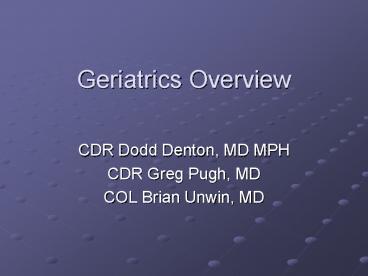Geriatrics Overview - PowerPoint PPT Presentation
1 / 20
Title:
Geriatrics Overview
Description:
Discuss the impact of heterogeneity in the care of elderly patients ... Just because a finding is common in the elderly doesn't mean it's normal ... – PowerPoint PPT presentation
Number of Views:152
Avg rating:3.0/5.0
Title: Geriatrics Overview
1
Geriatrics Overview
- CDR Dodd Denton, MD MPH
- CDR Greg Pugh, MD
- COL Brian Unwin, MD
2
Goals
- After reviewing this module, the student will be
able to - Discuss clinical demographics and epidemiology of
geriatric medicine - Compare and contrast normal and abnormal changes
with aging - Discuss the impact of heterogeneity in the care
of elderly patients - Define the weak link geriatrics concept
3
Geriatrics Will be part of your practice
- Persons aged 65 will make up
- 14 of our population by 2010
- 25 by 2050
- Five percent of the US population in 2050 will be
greater than age 85 - Persons aged 65 currently account for
- 33 of office visits and
- will become 50 of office visits
- Account for 1/3 of our health care dollar
4
Geriatric Patients
- Regardless of your future choice of specialty
- Theyre coming!!!
5
Heterogeneity
- As people age, they become more dissimilar than
similar in terms of individual physiology. For
example - A group of 30 year olds has similar
cardiovascular endurance, lung capacity,
cognitive ability - A group of 80 year olds may differ much more in
basic physiology - With this heterogeneity in function, must know
whats normal to recognize disease
6
Normal Changes with Aging
- Skeleton
- Decreased height and weight (after age 80)
- Loss of bone substance (osteopenia)
- Kidney
- Decreased creatinine, renal blood flow and
concentration ability - Gastrointestinal Tract
- Decreased acid (Vitamin B12 related)
- Fewer taste buds
7
Normal Changes with Aging
- Eyes
- Arcus senilis
- Decreased acuity, accommodation, color
sensitivity, depth perception - Hyperopia (far-sightedness)
- Hearing
- Degenerative changes of ossicles
- Obstruction of eustachian tube
- Atrophy of cochlear hair cells
- High frequency hearing loss and pitch
discrimination
8
Normal Changes with Aging
- Nervous system
- Increased motor response time
- Slower psychomotor performance
- Slowing intellectual performance
- Decreased complex learning
- Decreased hours of sleep
9
Common versus Normal
- Just because a finding is common in the elderly
doesnt mean its normal - Hypertension, osteoarthritis, and dementia are
common in the elderly but not normal - Patients only discuss things with you that they
feel are abnormal - If your patient considers incontinence a normal
part of aging, he/she wont bring it up during a
clinic visit. - Patient expectations are often wrong
10
Disability and Disease
- Geriatric disorders are usually disabilities
rather than discretely defined diseases - ADL (Activities of Daily Living) and IADL
(Instrumental Activities of Daily Living)
difficulties increase with age - Less than 10 percent of those 65-69 need help
with IADL/ADL - 60 of females over 85 living in the community
needed help with IADLs, and 40 required help
with ADLs
11
Activities of Daily Living (ADL)
- Activities of Daily Living (ADL) include
- Dressing
- Eating
- Walking
- Going to the bathroom
- Bathing
- These are severe functional disabilities and
define dependency
12
Instrument Activities of Daily Living (IADL)
- IADL include
- Shopping
- Housekeeping
- Accounting/bill paying
- Food/meal preparation
- Travel/driving
- These are less severe than ADL, but clearly cause
dysfunction and lead to dependency
13
Weak Link Concept
- Many elderly have one system that is their weak
link. Examples - CNS dementia, hx of strokes, etc.
- Neuromuscular neuropathy, osteoarthritis,
deconditioning, etc. - Genitourinary incontinence, prostatism, etc.
- This weak link influences the presentation of
diseases
14
Disease presents differently
- A 90 yo with dementia who develops pneumonia
- may present with delirium
- A 90 yo with osteoarthritis and neuropathy who
develops pneumonia - may present with a fall
- A 90 yo with no weak link who develops
pneumonia - may present typically fever, chills,
productive cough, etc.
15
Hard to Cure Syndromes
- Geriatric syndromes may be perceived as difficult
or impossible to treat and cure. - However, a thorough evaluation often reveals many
minor contributing disorders that can be
improved, resulting in overall effective
treatment - Our job may not be to cure disease in the
elderly, but to improve function
16
For Instance
- In a patient complaining of nocturia x3 who has
an enlarged prostate, an internist may start an
alpha blocker - A geriatrician would
- Evaluate his medication list and move the
diuretic to morning dosing or eliminate it - Address sleep hygiene issues (no caffeine before
bedtime, no water within 2 hours, etc) - Discuss timed voiding
- Multiple tweaks may result in improved function
17
Anticipatory Management
- Identification of a geriatric syndrome can lead
to anticipation and avoidance of complications - After diagnosis of dementia, anticipate delirium
with psychoactive drugs or infections - After diagnosis of neuropathy, anticipate falls
or hip fracture. - Look for vitamin D deficiency
- Start bisphosphonate
- Counsel caregiver
- Might not completely avoid these, but can at
least prepare the patient and family
18
Mental Status Changes
- Dementia is a disease of aging, but not a normal
consequence of aging - There are many subtypes (see dementia module on
the CDROM for more details) - Delirium occurs as a complication of many disease
states in the elderly - Changes in mental status are the hallmark of
dementia and delirium - Familiarity with the mini-mental status
examination is essential to be able to evaluate
mental status!
19
(No Transcript)
20
Last slide
- Please refer to the other modules, which cover
these topics in more detail.































